Abstract
Crucian carp (Carassius carassius) is a key fish species in most Chinese subtropical and tropical shallow lakes. Through sediment feeding, crucian carp could greatly change water turbidity and nutrient levels, as well as the abundance of herbivorous consumers, which may have important influences on seston element stoichiometry. However, so far, experimental studies on this topic are lacking. We conducted a 36-day mesocosm experiment to explore the effects of crucian carp on water physicochemical and biological properties, and C/N/P ratios in suspended particulate matter (SPM) under eutrophic conditions. Our results provided three major findings: (1) Crucian carp resuspended sediments and along with them, reduced light penetration and lower light/total phosphorus (TP) ratios. (2) Crucian carp reduced biomasses of both zooplankton and macrozoobenthos, whereas their effect on phytoplankton was weak, potentially because of resuspension-induced light limitation. (3) Both C/P and N/P ratios in SPM were significant lower in mesocosms with crucian carp than in fish-free controls, which may be attributed to the high contribution of P-rich sediments and low light to nutrient supply caused by fish-induced resuspension. Our results suggest that besides planktivorous fish, benthivore (e.g., crucian carp) in warm shallow waters could also affect pelagic C/N/P stoichiometry via sediment feeding, which may further influence energy transfer efficiency in lake food chain.
1. Introduction
The carbon (C), nitrogen (N), and phosphorus (P) content, and stoichiometric ratio of suspended particulate matter (SPM) in lakes and oceans may affect the biogeochemical cycling, food chain energy transfer, and nutrient limitation in ecosystems [1,2,3]. For instance, the C/P ratio in lake seston might, in part, determine the food quality for planktonic herbivores, and thereby affect their growth and reproduction and, consequently, the energy transfer efficiency in the food chain [4]. Freshwater ecosystems often exhibit great variability of C/N/P ratios in particulate matter [1], influenced by issues such as lake hydrology (e.g., residence time [1]), physical–chemical conditions (e.g., light and nutrient conditions [5]), and food-web structure [6].
Fish have major effects on the nutrient dynamics and trophic structure in lake ecosystems. Previous studies have shown that changes in fish biomass and community could greatly alter pelagic C/N/P stoichiometry. For instance, a whole-lake fish manipulation experiment conducted in Lake 227, Ontario, Canada, showed that C/P and N/P molar ratios in lake particulate matter significantly declined after addition of northern pike (Esox lucius) [6]. In mesocosm studies, Dickman et al. (2008) and Mette et al. (2011) also found that the planktivory of larval gizzard shad (Dorosoma cepedianum) significantly reduced seston C/P and N/P ratios in their manipulated “low light and high nutrient” systems [4,7]. However, previous studies have mostly focused on planktivorous fish and their top-down effects [4,6,7], whereas little is known about how benthivorous fish, the dominant taxa in subtropical and tropical lakes, affect lake C/N/P stoichiometry.
Benthivorous fish often select food by sucking in sediment and ejecting all but the retained food particles back into the water column. The process often causes resuspension of sediments, resulting in an increase in turbidity, nutrient concentrations and algal biomass in the water column [8,9,10]. Furthermore, benthivorous fish also reduce zooplankton via direct grazing and/or indirect effects on suspended solids [11,12]. Therefore, benthivores have more complex influence on water physicochemical and biotic conditions than planktivorous fish [13,14]. Moreover, as different effects may counteract each other, predicting their overall impacts on element stoichiometry in lake SPM is difficult. Following the “light/nutrient” stoichiometric hypothesis, shallow lakes with abundant benthivorous fish should have low phytoplankton C/N and C/P ratios as sediment feeding of benthivores often cause high turbidity, leading to low light/nutrient ratios in the water column [9,15]. However, benthivorous fish may also create high algal C/N or C/P ratios by stimulating phytoplankton growth, reducing the availability of nutrients per algal cell [7,16]. Besides effects on cellular P content of autotrophs, benthivorous fish in shallow lakes could also lower C/P and N/P ratios by resuspending of sediments, which are often rich in P compared with C and N [17,18,19].
Crucian carp (Carassius carassius), a common benthivorous fish belonging to the Cyprinidae family, is widely distributed in subtropical and tropical Asian inland waters [20]. Crucian carp is also known to be an omnivore with a wide food spectrum that includes both animal (i.e., zooplankton, macroinvertebrates) and plant material (detritus, macrophytes) [21,22]. Thus, in subtropical and tropical China, crucian carp may be the most widespread species in both algae- and macrophyte-dominated lakes and be rapidly recruited after fish removal in restored lakes [23,24]. Recent mesocosm studies have revealed significant negative effects of crucian carp on water quality and ecological state of shallow lakes, e.g., stirring of sediments, entailing reduced water clarity, increasing nutrient levels, and phytoplankton biomass, and reducing zooplankton as well as submerged macrophytes [15,22]. However, to date, little is known about how crucian carp affects C/N/P stoichiometry in lake seston.
In this study, we conducted a 36-day mesocosm experiment to explore the effects of crucian carp on water physicochemical and biological properties, and particle C/N/P ratios under eutrophic conditions. We specially focused on C/P and N/P ratios as both parameters are important in energy transfer efficiency of the food chain [4] and for nutrient limitation in lakes [25]. We hypothesized that the sediment feeding of crucian carp would (1) increase phytoplankton biomass via both nutrient elevation and zooplankton loss as shown in previous studies [15,22]; (2) reduce C/P and N/P ratios in suspended particulate matter due to fish-induced low light to nutrient supply [5], and the increased contribution of P-rich sediments [16,17].
2. Materials and Methods
2.1. Experimental Design
The 36-day outdoor mesocosm experiment was conducted from 3 August to 8 September 2017, at Taihu Lake Laboratory Ecosystem Research Station, located in Meiliang Bay on the northern edge of Lake Taihu. Six cylindrical, high-density polyethylene tanks (95 cm height × 97 cm upper diameter × 77 cm bottom diameter) were filled with a 10 cm layer of lake sediment and 500 L of water collected from Meiliang Bay. According to monitoring data on Lake Taihu (30 sites) in 2017, the sediment TOC/TP and TN/TP molar ratios were 45.7 ± 17.7 and 3.6 ± 1.0 (means ± SD), respectively. The contents of sediment organic matter were 6.6% ± 1.5%. The sediments had previously been sieved (mesh size: 1.7 mm) to remove large invertebrates and mixed to ensure uniformity. The water was also screened using a 64 μm mesh filter to remove crustacean zooplankton before use. Juvenile crucian carp (Carassius carassius) with an average wet weight of 1.55 ± 0.14 g and an average body length of 4.5 ± 0.5 cm were obtained from local aquaculture ponds and acclimatized in lake water before initiation of the experiment. When the experiment began, three mesocosms were chosen for carp presence (two fish per tank), approximating a natural density of 70 kg ha−1, which is often recorded in Chinese subtropical or tropical restored lakes, for example, Lake Taihu [26] and Huizhou West Lake [23]. The remaining three mesocosms without crucian carp functioned as controls.
2.2. Sampling and Analytical Methods
Water samples were collected at 6-day intervals during the experiment. Prior to water sampling, the light intensity in each mesocosm was measured in situ at two depths (0 and 40 cm) using an underwater digital luxmeter (ZDS-10W, Shanghai, China). According to Sterner et al. (1997) [5], the mean irradiance (0–40 cm water depth) in each mesocosm was calculated using the following formula: Irradiance = [1-e−(KZ)]/(KZ), with Z being the depth where the light intensities were measured (constant value in our study, 0.4 m), and K the attenuation coefficient, calculated as K = (−1/Z) LN(E(Z)/E(0)) (E(Z) and E(0) are the light intensity at 40 cm and 0 cm depth, respectively). Thereafter, a tube sampler (8 cm diameter, 64 cm length) was used to collect 2 L depth-integrated water samples from each mesocosm. These water samples were subsequently taken to the laboratory for analyses of nutrients, chlorophyll a (Chl-a) levels, and elemental composition in SPM, as described below.
In the laboratory, a 500 mL subsample was used to measure nutrient and Chl-a concentrations. Total nitrogen (TN), total phosphorus (TP), total dissolved nitrogen (TDN), and total dissolved phosphorus (TDP) were determined through colorimetry after digestion with K2S2O8 and NaOH solution [27]. Chl-a concentrations were measured spectrophotometrically from matter retained on a GF/C filter and extracted in a 90% (v/v) acetone/water solution for 24 h. No correction was carried out for pheophytin interference [28]. The remaining water samples were screened through a 64 μm mesh to remove most zooplankton. Particulate matter from each mesocosm was obtained by filtering 400–1000 mL filtered water samples onto both pre-ashed (550 °C for 2 h) and pre-weighed GF/C filters (Whatman, Maidstone, UK). All filters were dried at 60 °C for 48 h and weighed to determine the total weight of solids (TS). After that, one of the filters was combusted in a muffle furnace at 550 °C for 2 h, cooled in a desiccator, and finally weighed to determine the weight of inorganic solids (IS). The organic fraction (OS) was calculated by subtracting IS from TS. The other filter was crushed into a fine powder to measure elemental composition. The C and N contents were measured using a CHNS Vario E1 III elemental analyzer, and the P content was determined by inductively coupled plasma–atomic emission spectrometry (ICP–AES). The C, N, and P contents in particulate matter were then used to calculate C/N, C/P, and N/P ratios, expressed in molar units.
Phytoplankton, zooplankton, and macrozoobenthos biomasses and communities were recorded at the end of the experiment (Day 36). For phytoplankton, a 500 mL depth-integrated water sample from each mesocosm was treated with 5 mL Lugol’s iodine solution and sedimented for 48 h. The supernatant was removed, and the residue was collected and examined at 100–400× magnification for enumeration. Phytoplankton were identified to genus level following [29]. The biomass of common phytoplankton taxa were calculated based on cell size measurements of at least 30 cells of each taxon and using formulae for geometric shapes approximating cell forms [30]. For less common taxa, biomass calculations were based on fewer measurements; otherwise, at least 1000 cells of each taxon were counted per sample. For zooplankton, rotifers were counted directly from phytoplankton samples at 100× magnification (at least 100 individuals of the most abundant taxa). Microcrustaceans (cladocerans and copepods) were collected by filtering depth-integrated water samples (10 L) through a 64 μm net followed by preservation in 4% formaldehyde. Crustacean zooplankton were counted at 40–100× magnification. Species identifications were made according to regional keys [31,32,33]. Zooplankton biomass (dry weight) was estimated using equations from Huang (1999) [34]. We measured up to 20 individuals of each taxon, whenever possible. To determine macrozoobenthos biomass and community composition, one sediment sample was taken from each mesocosm using a gravity corer with a 90 mm diameter coring tube and subsequently washed over a 500 μm mesh sieve. The retained macrozoobenthos (including chironomids and oligochaetes in our study) were identified in the laboratory according to Wang (2002) [35] and Tang (2006) [36].
Time series data (nutrients, irradiance, Chl-a concentration, and inorganic and organic solids as well as elemental composition of particulate matter) were statistically tested for effects of treatment, time, and their interactions by repeated measurements ANOVA (rmANOVA) after checking for normality and homogeneity of variance in the samples and residuals. If the assumption of sphericity of the variance–covariance matrices of the rmANOVA analyses was violated, the degrees of freedom (df) were corrected using Huynh–Feldt, resulting in an adjustment of the significance of the F ratio [37]. Student’s t tests were used to reveal the effects of crucian carp on phytoplankton, zooplankton, and macrozoobenthos biomasses and communities in the last sampling event. If necessary, the data were log10x transformed to meet the requirements of normal distribution and homogeneity of variance. All comparisons were conducted using the statistical package SPSS, version 16.0 (IBM Corporation, Somers, NY, USA).
3. Results
3.1. Nutrients and Light
No significant differences in TN and TDN concentrations were observed between the treatments during the experimental period (Figure 1a,b; Table 1), and the effects of fish on total and dissolved phosphorus concentrations (TP and TDP) were also insignificant although TP tended to be higher with carp present (Figure 1c,d; Table 1). The TN to TP ratios (TN/TP) were significant lower in mesocosms with fish than in the control (Figure 1e; Table 1).
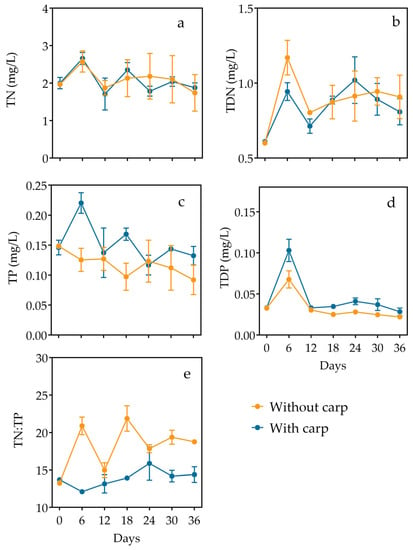
Figure 1.
Comparisons of concentrations in water of (a) total nitrogen (TN), (b) total dissolved nitrogen (TDN), (c) total phosphorus (TP), (d) total dissolved phosphorus (TDP), and (e) TN to TP ratios between the two treatments. Values denote mean ± SE (n = 3).

Table 1.
Detailed information on rmANOVA results on the effects of crucian carp (Carp) on total (TN, TP) and dissolved (TDN, TDP) nutrients, TN/TP ratios, irradiance, irradiance to total phosphorus ratios (Irradiance/TP), and chlorophyll a (Chl-a) concentrations during the experiment (Time).
The presence of crucian carp enhanced light attenuation, the irradiance being significantly lower in the fish-holding mesocosms than in the controls (Figure 2a; Table 1). The irradiance to total phosphorus ratios were also significantly lower in mesocosms with crucian carp than in the fish-absent mesocosms (Figure 2b; Table 1).
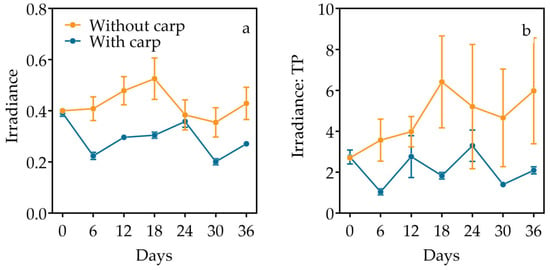
Figure 2.
Comparisons of (a) irradiance and (b) irradiance to total phosphorus (Irradiance/TP) ratios between the two treatments. Values denote mean ± SE (n = 3).
3.2. Phytoplankton, Zooplankton and Zoobenthos
Both treatments maintained high chlorophyll a levels (generally >50 μg L−1) during the experiment (Figure 3a), and the difference between treatments was not significant (Table 1). At the end of experiment, five phytoplankton phyla were recorded (Figure 3b). In the fish-present mesocosms, the phytoplankton was dominated by cyanophytes (main genera: Microcystis, Raphidiopsis, Aphanizomenon, Oscillatoria, and Anabaena), whereas cyanobacteria and chlorophytes (mainly Scenedesmus) were dominant in the control mesocosms. The proportion of cyanophytes of the phytoplankton assemblage tended to be higher in the mesocosms with crucian carp (76.3% on average) than in the fish-free controls (48.9% on average), though the difference was insignificant (t-test, p = 0.33; Figure 3b). However, the percentage of chlorophytes was significantly lower in the fish mesocosms (2.4% on average) than in the controls (42.5% on average) (t-test, p = 0.035; Figure 3b). The biomasses of the other three major phytoplankton phyla (Bacillariophyta, Dinophyta, and Cryptophyta) were low (Figure 3b) and did not differ significantly between treatments.
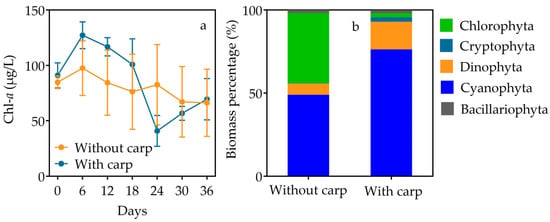
Figure 3.
Comparisons of (a) Chl-a concentration during the experimental period and (b) biomass percentage of phytoplankton phyla between the two treatments. Values denote mean ± SE (n = 3).
A total of 17 zooplankton taxa were recorded at the end of experiment, including 4 cladoceran genera (Bosmina, Ceriodaphnia, Moina, and Diaphanosoma), 2 copepod genera (Mesocyclops leuckarti and Sinocalanus dorrii), and 11 rotifer genera (dominated by Brachionus quadridentatus, B. forficula, B. angularis, Keratella cochlearis, K. tecta, and Polyarthra trigla). Bosmina was dominant in the control mesocosms, whilst Diaphanosoma prevailed in the fish mesocosms. The biomasses of total zooplankton, cladocerans, and rotifers were significantly lower in the mesocosms with crucian carp than in fish-free controls (t-test, p < 0.001 for total zooplankton and cladocerans; p = 0.019 for rotifers; Figure 4). No significant differences in the effect of crucian carp were observed for copepod biomass (t-test, p = 0.186; Figure 4).
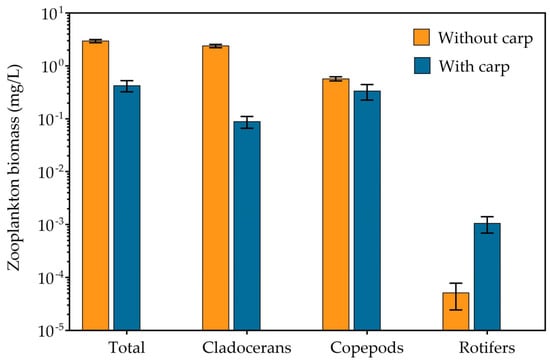
Figure 4.
Comparisons of total zooplankton, cladoceran, copepod, and rotifer biomass between the fish-present and -absent treatments. Values denote mean ± SE (n = 3).
At the end of experiment, three macrozoobenthos taxa (Limnodrilus hoffmeisteri, Chironomus flaviplumus, and Tanypus chinensis) were recorded in all mesocosms. The total biomass of macrozoobenthos was significantly lower in the fish-present mesocosms than in the fish-absent ones (t-test, p = 0.032; Figure 5).
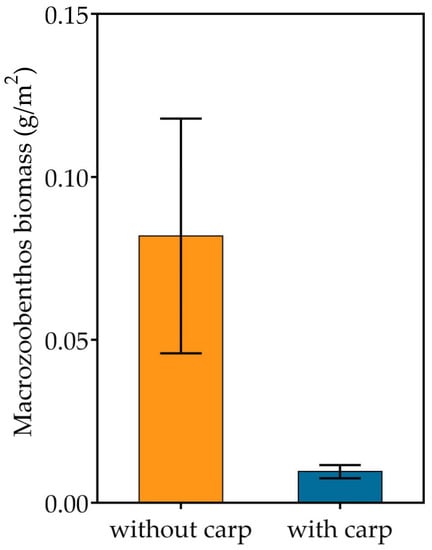
Figure 5.
Comparisons of macrozoobenthos biomass between the fish-present and -absent treatments. Values denote mean ± SE (n = 3).
3.3. Inorganic and Organic Partition and Elemental Composition in Particulate Matter
Sediment resuspension induced by crucian carp foraging likely enhanced the inorganic solids in SPM as indicated by significantly higher TS and IS concentrations and IS% in the mesocosms with carp than in the controls (Table 2; Figure 6a,b,d). As for Chl-a, the concentrations of OS were not significantly different between the two treatments (Table 2; Figure 6c).

Table 2.
Detailed information on rmANOVA results on the effects of crucian carp (Carp) on total (TS), inorganic (IS) and organic (OS) solids, and carbon (C), nitrogen (N) and phosphorus (P) composition during the experiment (Time).
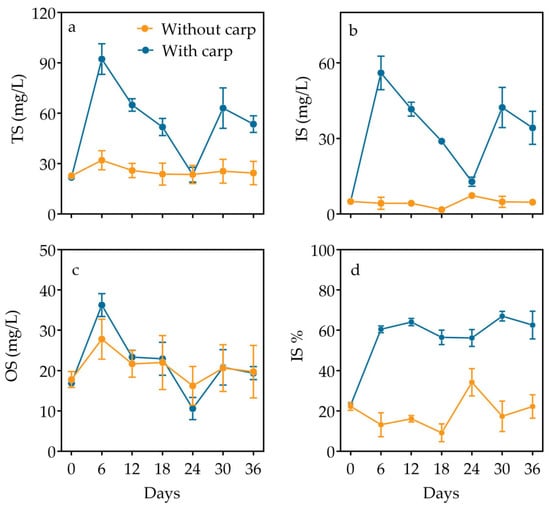
Figure 6.
Comparisons of (a) total (TS), (b) inorganic (IS), (c) organic (OS) solid mass, and (d) percentage of IS in TS (IS%) between the fish-present and -absent treatments. Values denote mean ± SE (n = 3).
Crucian carp significantly lowered C, N, and P contents in SPM (Figure 7a–c; Table 2), but the decline in the proportion of P was much lower than those of C and N (Figure 7a–c). Accordingly, C/P and N/P ratios, as well as C/N, were significantly lower in the mesocosms with crucian carp than in the control mesocosms (Figure 7d–f; Table 2).
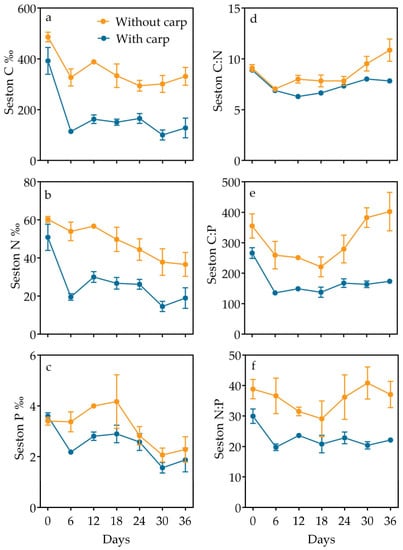
Figure 7.
Comparisons of C, N, P contents (a–c) and molar ratios of (d) carbon to phosphorus (C/P), (e) carbon to nitrogen (C/N), and (f) nitrogen to phosphorus (N/P) in suspended particulate matter (SPM) between the fish-present and -absent treatments. Values denote mean ± SE (n = 3).
4. Discussion
Our mesocosm experiment was conducted with the aim to explore how benthivorous crucian carp affected plankton biomass and, more importantly, the C/N/P stoichiometry in eutrophic shallow lakes. We expected that the sediment feeding of crucian carp would boost phytoplankton growth and simultaneously lead to lower seston C/P and N/P ratios. Our findings will be discussed in detail below with reference to the working hypotheses.
Hypothesis 1.
Crucian carp will increase phytoplankton biomass via both nutrient elevation and zooplankton loss.
This hypothesis was not fully supported as although zooplankton biomass was significant reduced by crucian carp (Figure 4), no significant difference in the water Chl-a concentration was observed between the carp-present and -absent mesocosms (Figure 3a).
The major decrease in zooplankton biomass indicates that besides predating on benthic organisms (Figure 5), crucian carp could also reduce zooplankton, potentially affecting their control of pelagic phytoplankton. Crucian carp is an omnivore, and previous gut content analyses have revealed that it may prey directly upon zooplankton, creating a community shift in dominance from large-sized cladocerans and copepods to small-sized rotifers [12]. This was exactly the pattern observed in our study (Figure 4). Moreover, fish-induced sediment resuspension is known to affect the feeding rate and metabolism of zooplankton [11], and this may have indirectly contributed to the observed reduction of filter-feeding cladocerans occurring in our study (Figure 4).
Despite the reduced top-down control of phytoplankton, water Chl-a concentrations did not increase correspondingly (Figure 3a) in these eutrophic mesocosms, in contrast to the results in similar mesocosm studies in which a clear increase in phytoplankton growth was found after introduction of crucian carp [12,15,22]. We attributed this discrepancy to the different trophic states of these mesocosm experiments. The Chl-a concentrations of Gu et al. (2016) and He et al. (2017) were consistently <25 μg L−1 in the mesocosms without fish [12,15], which is much lower than the level of our mesocosms (around 100 μg L−1 in the fish-absent mesocosms). Thus, the high standing biomass of phytoplankton, and increased levels of inorganic particles in our mesocosms with fish (Figure 6b), may collectively have reduced light penetration sufficiently to maintain Chl-a concentrations in the crucian carp-holding mesocosms at the same level as in those without fish. Similarly, Wahl et al. (2011) and Badiou and Goldsborough (2015) found that light attenuation caused by common carp limited the growth of phytoplankton in their eutrophic mesocosms (Chl-a >100 μg L−1 when fish were absent) [38,39]. Thus, the net effect of crucian carp on phytoplankton growth may depend on the trophic status of shallow lakes. Nonetheless, from a perspective of lake management, our study still supports the view that benthivorous fish like crucian carp would deteriorate water quality and ecological status due to the fish-induced high turbidity (Figure 2a) and the loss of herbivorous zooplankton (Figure 4).
In our study, crucian carp had no overall effects on nutrient (especially P) concentrations (Figure 1a–d). The unchanged TP concentrations may be partly explained by compositional changes in the total P pool between the fish-absent and -present hypertrophic mesocosms. That is, benthic feeding of crucian carp largely increased suspended solid concentrations (Figure 6a), leading to elevated particle-P in the water column. At the same time, the loss of zooplankton biomass (Figure 4) reduced zooplankton-P in the fish mesocosms which, to some extent, counteracted the increase of particle-P. If we assume a body P content of 1% in the dominant species of our study [40]—Bosmina and Diaphanosoma—the loss of zooplankton-P (zooplankton biomass × body P content) can be calculated to an average of 0.025 mg/L on Day 36. At the same time, the increase in the particle-P concentration (TS concentration × P content in particulate matter) was, on average, 0.034 mg/L at the same sampling event. Moreover, crucian carp gained much weight (from 1.55 to 8.44 g/ind) during the 36-day experiment. Using an average body P content of 0.6% in cyprinid fishes [41], the increment of fish body P content in each mesocosm is equivalent to 0.16 mg P/L in the water. Thus, the P levels in the fish mesocosms (water and biota in the water) was much higher than in the controls if considering the increase in fish body nutrient concentrations.
Hypothesis 2.
Crucian carp will lower C/P and N/P ratios in suspended particulate matter.
This hypothesis was supported. Both C/P and N/P ratios in the mesocosms with crucian carp were significantly lower than in the fish-free mesocosms (Figure 7e,f). Fish-induced an increased contribution of P-rich sediments in suspended particulate matter, indicated by high IS percentage (Figure 6d), is an important reason for the low C/P and N/P ratios. In our study, the C, N, and P contents all decreased significantly in the mesocosms with high IS% (Figure 7a–c), reflecting that inorganic particles have lower C, N, and P contents than organic particles. However, the decline of P content (P‰, Figure 7c) was much lower than that of C and N contents (Figure 7a,b), which resulted in particulate matter with a high proportion of sediments that yielded low C/P and N/P ratios (Figure 7e,f).
In our study, benthic-feeding crucian carp caused high turbidity, resulting in low light penetration and light to nutrient ratios (Figure 2a,b). Meanwhile, phytoplankton growth was likely constrained by light attenuation (Figure 3a). According to the light/nutrient stoichiometric hypothesis [5], light-limited phytoplankton may take up nutrients excessively in eutrophic waters. Thus, algal cellular nutrient contents in our fish-present mesocosms may be higher, which potentially contributed to the low C/N and C/P ratios in particulate matter (Figure 7e). Furthermore, the decline in chlorophyte dominance within the phytoplankton community (Figure 3b) may also have contributed to the low C/P ratios in the fish mesocosms as this algae phylum supposedly has higher C/P ratios than other algal groups [7,16].
Our results, low N/P ratios in mesocosms with crucian carp, concur with Niemistö et al. (2008) and Holmroos et al. (2012), who found sediment resuspension (driven by wind) in shallow lakes decreased the TN/TP ratio in the water [17,18]. However, we cannot exclude the effect of fish excretion on N/P ratios of particulate matter in our fish-present mesocosms [42], although we did not directly measure the N/P excretion rates of crucian carp. Investigations conducted by Sterner and George (2000) found that differences in body C, N, and P contents among cyprinid species were small, with a molar C/N/P ratio of 242:16:1. Moreover, they found that the N/P ratio of the cyprinids and of their gut contents was nearly identical, and they therefore deduced that cyprinids egest and excrete nutrients at an N/P ratio close to 15 [43]. Similarly, Schaus et al. (1997) estimated the nutrient excretion of gizzard shad in a eutrophic reservoir (Acton Lake, Ohio) and found a molar N/P ratio of 16.8 (± 0.9 SE) [42]. Thus, if crucian carp (also a cyprinid) follows the same pattern, their excretion effect would lead to lower seston N/P ratios, as the fish-recycled N/P ratio (presumably 16) was much lower than the seston N/P ratios in our study (typically >30 in the fish-absent mesocosms).
Our results differ from those of Schaus and Vanni (2000) who found that sediment feeding by small gizzard shad increased C/P and N/P ratios of lake particulate matter [44]. This may be explained by the fact that gizzard shad in their experiment significantly increased both inorganic particles and phytoplankton biomass, leading to no change in the contribution of resuspended sediments to particulate matter. In addition, the increased algal biomass resulted in high C/P, and thereby mediated the effects of fish-induced low light to nutrient supply in their fish-present mesocosms.
Potential Implications for Trophic Interactions
In aquatic ecosystems, the carbon, nitrogen, and phosphorus stoichiometry in SPM are crucial at lower trophic levels as a source of energy for bacteria, protozoan, and zooplankton [45,46,47]. Previous studies have revealed the influence of planktivorous fish on seston C/N/P ratios in temperate waterbodies [6,7]. However, how benthivorous fish affect elemental contents and stoichiometry of lake suspended particles remains ambiguous. Our study showed that crucian carp, a key fish in warm water lakes, would lower particle C, N, P contents via benthic feeding, and lead to low seston C/P and N/P ratios in shallow eutrophic lakes (Figure 7a–f). From a stoichiometry perspective, the alterations in particle composition (e.g., increase proportion of inorganic solids) and C/N/P ratios induced by crucian carp may influence the growth of pelagic consumers and, thereby, affect energy transfer efficiency in the lake food chain to some extent [4,11,47].
Author Contributions
H.H., Y.H., and K.L. designed the study, H.H., Y.H., and Q.L. conducted the sampling, H.H., J.Y., E.J., and Z.L. conducted the data analyses and wrote the paper.
Funding
This study was supported by Chinese National Key Research and Development Project (2017YFA0605201), National Science Foundation of China (31770509, 41877415, 41571086), NIGLAS 135 Project (NIGLAS2017GH01, NIGLAS2018GH04), National Water Pollution Control and Management Technology Major Projects of China (2017ZX07203-005) and Science and Technology Service Network Initiative (KFJ-STS-ZDTP-038-3). E.J. was supported by AQUACOSM (Network of Leading European AQUAtic MesoCOSM Facilities Connecting Mountains to Oceans from the Arctic to the Mediterranean), AnaEE Denmark (anaee.dk) and the Centre for Water Technology at Aarhus University (watec.au.dk).
Acknowledgments
The authors wish to express their gratitude to Xiaoxia Chen, You Zhang and Ruijie Shen for their assistance in field and laboratory work and Anne Mette Poulsen for linguistic assistance.
Conflicts of Interest
The authors declare no conflict of interest.
References
- Hecky, R.E.; Campbell, P.; Hendzel, L.L. The Stoichiometry of carbon, nitrogen, and phosphorus in particulate matter of lakes and oceans. Limnol. Oceanogr. 1993, 38, 709–724. [Google Scholar] [CrossRef]
- Sterner, R.W.; Andersen, T.; Elser, J.J.; Hessen, D.O.; Hood, J.M.; McCauley, E.; Urabe, J. Scale-dependent carbon:nitrogen: Phosphorus seston stoichimetry in marine and freshwaters. Limnol. Oceanogr. 2008, 53, 1169–1180. [Google Scholar] [CrossRef]
- Elser, J.J.; Kyle, M.; Steuer, L.; Nydick, K.R.; Baron, J.S. Nutrient availability and phytoplankton nutrient limitation across a gradient of atmospheric nitrogen deposition. Ecology 2009, 90, 3062–3073. [Google Scholar] [CrossRef] [PubMed]
- Dickman, E.M.; Newell, J.M.; González, M.J.; Vanni, M.J. Light, nutrients, and food-chain length constrain planktonic energy transfer efficiency across multiple trophic levels. Proc. Natl. Acad. Sci. USA 2008, 105, 18408–18412. [Google Scholar] [CrossRef] [PubMed]
- Sterner, R.W.; Elser, J.J.; Fee, E.J.; Guildford, S.J.; Chrzanowski, T.H. The light: Nutrient ratio in lakes: The balance of energy and materials affects ecosystem structure and process. Am. Nat. 1997, 150, 663–684. [Google Scholar] [CrossRef] [PubMed]
- Elser, J.J.; Sterner, R.W.; Galford, A.E.; Chrzanowski, T.H.; Findlay, D.L.; Mills, K.H.; Paterson, M.J.; Stainton, M.J.; Schindler, D.W. Pelagic C:N:P stoichiometry in a eutrophied lake: Responses to a whole-lake food-web manipulation. Ecosystems 2000, 3, 293–307. [Google Scholar] [CrossRef]
- Mette, E.M.; Vanni, M.J.; Newell, J.M.; Gonzàlez, M.J. Phytoplankton communities and stoichiometry are interactively affected by light, nutrients, and fish. Limnol. Oceanogr. 2011, 56, 1959–1975. [Google Scholar] [CrossRef]
- Weber, M.J.; Brown, M.L. Effects of common carp on aquatic ecosystems 80 years after “Carp as a Dominant”: Ecological insights for fisheries management. Rev. Fish. Sci. 2009, 17, 524–537. [Google Scholar] [CrossRef]
- Richardson, M.J.; Whoriskey, F.G.; Roy, L.H. Turbidity generation and biological impacts of an exotic fish Carassius auratus, introduced into shallow seasonally anoxic ponds. J. Fish Biol. 1995, 47, 576–585. [Google Scholar] [CrossRef]
- Ruppert, J.L.; Docherty, C.; Neufeld, K.; Hamilton, K.; MacPherson, L.; Poesch, M.S. Native freshwater species get out of the way: Prussian carp (Carassius gibelio) impacts both fish and benthic invertebrate communities in North America. R. Soc. Open Sci. 2017, 4, 170400. [Google Scholar] [CrossRef]
- Hart, R.C. Zooplankton feeding rates in relation to suspended sediment content: Potential influences on community structure in a turbid reservoir. Freshw. Biol. 1988, 19, 123–139. [Google Scholar] [CrossRef]
- Gu, J.; Jin, H.; He, H.; Ning, X.Y.; Yu, J.L.; Tan, B.C.; Jeppesen, E.; Li, K.Y. Effects of small-sized crucian carp (Carassius carassius) on the growth of submerged macrophytes: Implications for shallow lake restoration. Ecol. Eng. 2016, 95, 567–573. [Google Scholar] [CrossRef]
- Zhang, X.; Liu, Z.; Jeppesen, E.; Taylor, W.D.; Rudstam, L.G. Effects of benthic-feeding common carp and filter-feeding silver carp on benthic-pelagic coupling: Implications for shallow lake management. Ecol. Eng. 2016, 88, 256–264. [Google Scholar] [CrossRef]
- Dantas, D.D.F.; Rubim, P.L.; de Oliveira, F.A.; da Costa, M.R.; de Moura, C.G.; Teixeira, L.H.; Attayde, J.L. Effects of benthivorous and planktivorous fish on phosphorus cycling, phytoplankton biomass and water transparency of a tropical shallow lake. Hydrobiologia 2018, 829, 31–41. [Google Scholar] [CrossRef]
- He, H.; Hu, E.; Yu, J.L.; Luo, X.G.; Li, K.Y.; Jeppesen, E.; Liu, Z. Does turbidity induced by Carassius carassius limit phytoplankton growth? A mesocosm study. Environ. Sci. Pollut. Res. 2017, 24, 5012–5018. [Google Scholar] [CrossRef]
- Hall, S.R.; Leibold, M.A.; Lytle, D.A.; Smith, V.H. Grazers, producer stoichiometry, and the light: Nutrient hypothesis revisited. Ecology 2007, 88, 1142–1152. [Google Scholar] [CrossRef]
- Holmroos, H.; Hietanen, S.; Niemistö, J.; Horppila, J. Sediment resuspension and denitrification affect the nitrogen to phosphorus ratio of shallow lake waters. Fundam. Appl. Limnol. 2012, 180, 193–205. [Google Scholar] [CrossRef]
- Niemistö, J.; Holmroos, H.; Pekcan-Hekim, Z.; Horppila, J. Interactions between sediment resuspension and sediment quality decrease the TN: TP ratio in a shallow lake. Limnol. Oceanogr. 2008, 53, 2407–2415. [Google Scholar] [CrossRef]
- Yang, Y.; Liu, Q. Spatial distribution of sediment carbon, nitrogen and phosphorus and pollution evaluation of sediment in Taihu Lake Basin. Acta Sci. Circumst. 2014, 34, 3057–3064. (In Chinese) [Google Scholar]
- FAO. Cultured Aquatic Species Information Programme: Carassius carassius. Available online: http://www.fao.org/fishery/culturedspecies/Carassius_carassius/en (accessed on 13 March 2019).
- Yu, J.; Liu, Z.; He, H.; Guan, B.H.; Chen, F.Z.; Li, K.Y.; Zhong, P.; Teixeira-de Mello, F.; Jeppesen, E. Submerged macrophytes facilitate dominance of omnivorous fish in a subtropical shallow lake: Implications for lake restoration. Hydrobiologia 2016, 775, 97–107. [Google Scholar] [CrossRef]
- Gu, J.; He, H.; Jin, H.; Yu, J.L.; Jeppesen, E.; Nairn, R.W.; Li, K.Y. Synergistic negative effects of small-sized benthivorous fish and nitrogen loading on the growth of submerged macrophytes—Relevance for shallow lake restoration. Sci. Total Environ. 2018, 610–611, 1572–1580. [Google Scholar] [CrossRef] [PubMed]
- Gao, J.; Liu, Z.; Jeppesen, E. Fish community assemblages changed but biomass remained similar after lake restoration by biomanipulation in a Chinese tropical eutrophic lake. Hydrobiologia 2014, 724, 127–140. [Google Scholar] [CrossRef]
- Liu, Z.; Hu, J.R.; Zhong, P.; Zhang, X.F.; Ning, J.J.; Larsen, S.E.; Chen, D.Y.; Gao, Y.M.; He, H.; Jeppesen, E. Successful restoration of a tropical shallow eutrophic lake: Strong bottom-up but weak top-down effects recorded. Water Res. 2018, 146, 88–97. [Google Scholar] [CrossRef] [PubMed]
- Conley, D.J.; Paerl, H.W.; Howarth, R.W.; Boesch, D.F.; Seitzinger, S.P.; Havens, K.E.; Lancelot, C.; Likens, G.E. Controlling Eutrophication: Nitrogen and phosphorus. Science 2009, 323, 1014–1015. [Google Scholar] [CrossRef]
- Liu, E.S.; Liu, Z.; Bao, C.H. The changes of catches of Carassius auratus and relationship with environment in Lake Taihu, China. J. Lake Sci. 2007, 19, 345–350. (In Chinese) [Google Scholar]
- Jin, X.; Tu, Q. The Standard Methods for Obervation and Analysis in Lake Eutrophication; Environmental Science Press: Beijing, China, 1990. (In Chinese) [Google Scholar]
- SEPA. Analytical Methods for Water and Wasterwater Monitor, 4th ed.; Chinese Environmental Science Press: Beijing, China, 2002. (In Chinese) [Google Scholar]
- Hu, H.J. The Freshwater Algae of China: Systematics, Taxonomy and Ecology; Science Press: Beijing, China, 2006. (In Chinese) [Google Scholar]
- Zhang, Z.; Huang, X. Methods in Freshwater Plankton Study; Science Press: Beijing, China, 1991. (In Chinese) [Google Scholar]
- Wang, J.J. Fauna Sinica, Rotifer; Science Press: Beijing, China, 1961. (In Chinese) [Google Scholar]
- Chiang, S.C.; Du, N.S. Fauna Sinica, Crustacea; Science Press: Beijing, China, 1979. (In Chinese) [Google Scholar]
- Shen, J.R.; Du, N.S. Fauna Sinica, Crustacea, Freshwater Copepoda; Science Press: Beijing, China, 1979. (In Chinese) [Google Scholar]
- Huang, X.F. Survey Observation and Analysis of Lake Ecology; Standards Press of China: Beijing, China, 1999. (In Chinese) [Google Scholar]
- Wang, H.Z. Studies on Taxonomy, Distribution and Ecology of Microdrile Oligochaetes of China, with Descriptions of Two New Species from the Vicinity of the Great Wall Station of China, Antarctica; Higher Education Press: Beijing, China, 2002. (In Chinese) [Google Scholar]
- Tang, H. Biosystematic Study on the Chironomid Larvae in China (Diptera, Chironomidae); Nankai University: Tianjin, China, 2006. (In Chinese) [Google Scholar]
- Huynh, H.; Feldt, L.S. Estimation of the box correction for degrees of freedom from sample data in randomized block and split-plot designs. J. Educ. Stat. 1976, 1, 69–82. [Google Scholar] [CrossRef]
- Wahl, D.H.; Wolfe, M.D.; Santucci, V.J.; Freedman, J.A. Invasive carp and prey community composition disrupt trophic cascades in eutrophic ponds. Hydrobiologia 2011, 678, 49–63. [Google Scholar] [CrossRef]
- Badiou, P.H.J.; Goldsborough, L.G. Ecological impacts of an exotic benthivorous fish, the common carp (Cyprinus carpio L.), on water quality, sedimentation, and submerged macrophyte biomass in wetland mesocosms. Hydrobiologia 2015, 755, 107–121. [Google Scholar] [CrossRef]
- Andersen, T.; Hessen, D.O. Carbon, nitrogen, and phosphorus content of freshwater zooplankton. Limonol. Oceanogr. 1991, 36, 807–814. [Google Scholar] [CrossRef]
- Penczak, T. Phosphorus, nitrogen, and carbon cycling by fish populations in two small lowland rivers in Poland. Hydrobiologia 1985, 120, 159–165. [Google Scholar] [CrossRef]
- Schaus, M.H.; Vanni, M.J.; Wissing, T.E.; Bremigan, M.T.; Garvey, J.E.; Stein, R.A. Nitrogen and phosphorus excretion by detritivorous gizzard shad in a reservoir ecosystem. Limnol. Oceanogr. 1997, 42, 1386–1397. [Google Scholar] [CrossRef]
- Sterner, R.W.; George, N.B. Carbon, nitrogen, and phosphorus stoichiometry of cyprinid fishes. Ecology 2000, 81, 127–140. [Google Scholar] [CrossRef]
- Schaus, M.H.; Vanni, M.J. Effects of gizzard shad on phytoplankton and nutrient dynamics: Role of sediment feeding and fish size. Ecology 2000, 81, 1701–1719. [Google Scholar] [CrossRef]
- Chrzanowski, T.H.; Grover, J.P. The light: Nutrient ratio in lakes: A test of hypothesized trends in bacterial nutrient limitation. Ecol. Lett. 2001, 4, 453–457. [Google Scholar] [CrossRef]
- Golz, A.; Burian, A.; Winder, M. Stoichiometric regulation in micro- and mesozooplankton. J. Plankton Res. 2015, 37, 293–305. [Google Scholar] [CrossRef]
- Laspoumaderes, C.; Modenutti, B.; Elser, J.J.; Balseiro, E. Does the stoichiometric carbon: Phosphorus knife edge apply for predaceous copepods? Oecologia 2015, 178, 557–569. [Google Scholar] [CrossRef] [PubMed]
© 2019 by the authors. Licensee MDPI, Basel, Switzerland. This article is an open access article distributed under the terms and conditions of the Creative Commons Attribution (CC BY) license (http://creativecommons.org/licenses/by/4.0/).